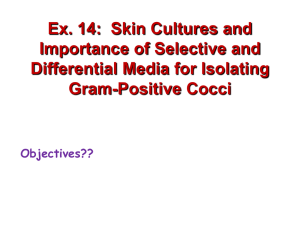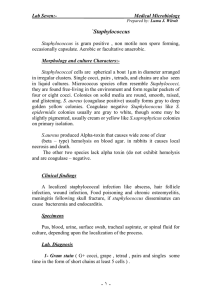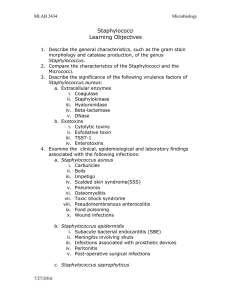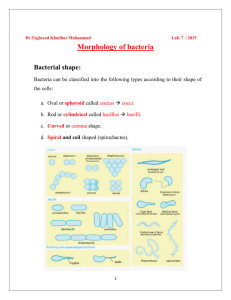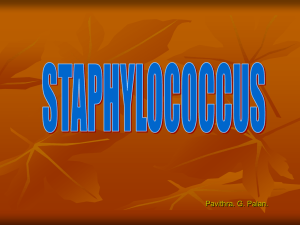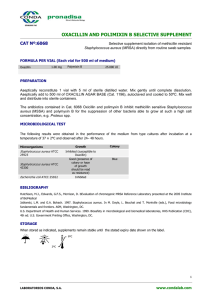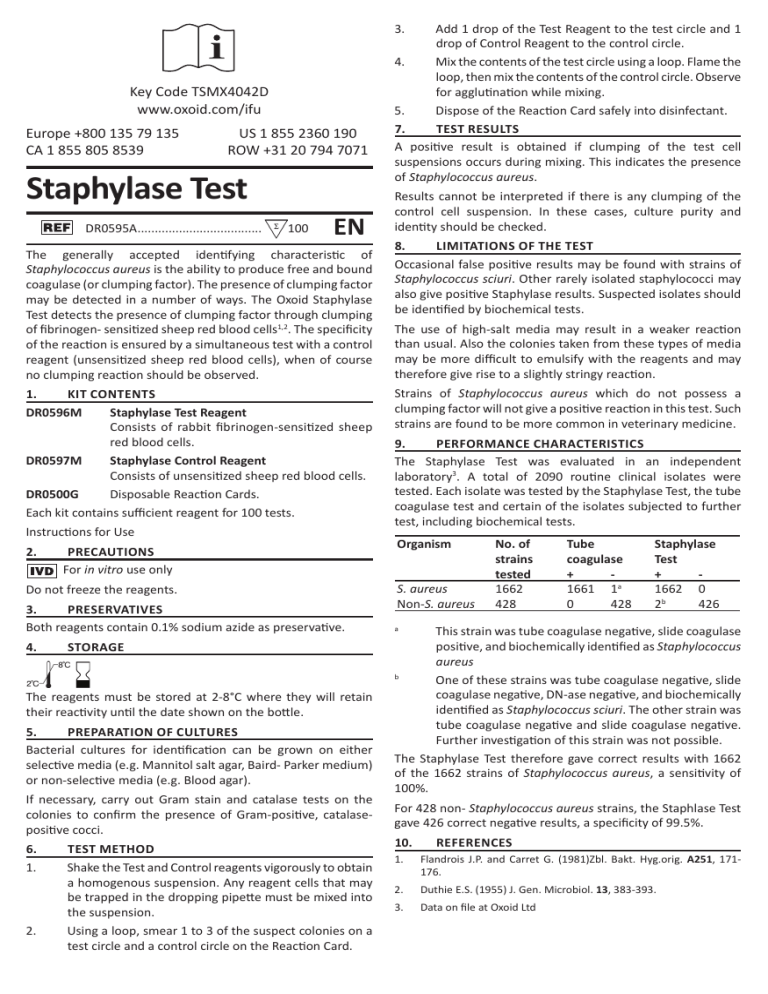
3. Key Code TSMX4042D www.oxoid.com/ifu Europe +800 135 79 135 CA 1 855 805 8539 US 1 855 2360 190 ROW +31 20 794 7071 Staphylase Test DR0595A..................................... 100 EN The generally accepted identifying characteristic of Staphylococcus aureus is the ability to produce free and bound coagulase (or clumping factor). The presence of clumping factor may be detected in a number of ways. The Oxoid Staphylase Test detects the presence of clumping factor through clumping of fibrinogen- sensitized sheep red blood cells1,2. The specificity of the reaction is ensured by a simultaneous test with a control reagent (unsensitized sheep red blood cells), when of course no clumping reaction should be observed. 1. KIT CONTENTS DR0596M Staphylase Test Reagent Consists of rabbit fibrinogen-sensitized sheep red blood cells. DR0597M Staphylase Control Reagent Consists of unsensitized sheep red blood cells. DR0500G Disposable Reaction Cards. Each kit contains sufficient reagent for 100 tests. Instructions for Use 2. PRECAUTIONS For in vitro use only Do not freeze the reagents. 3. PRESERVATIVES Both reagents contain 0.1% sodium azide as preservative. 4. STORAGE The reagents must be stored at 2-8°C where they will retain their reactivity until the date shown on the bottle. 5. PREPARATION OF CULTURES Bacterial cultures for identification can be grown on either selective media (e.g. Mannitol salt agar, Baird- Parker medium) or non-selective media (e.g. Blood agar). If necessary, carry out Gram stain and catalase tests on the colonies to confirm the presence of Gram-positive, catalasepositive cocci. 6. 1. 2. TEST METHOD Shake the Test and Control reagents vigorously to obtain a homogenous suspension. Any reagent cells that may be trapped in the dropping pipette must be mixed into the suspension. Using a loop, smear 1 to 3 of the suspect colonies on a test circle and a control circle on the Reaction Card. Add 1 drop of the Test Reagent to the test circle and 1 drop of Control Reagent to the control circle. 4. Mix the contents of the test circle using a loop. Flame the loop, then mix the contents of the control circle. Observe for agglutination while mixing. 5. Dispose of the Reaction Card safely into disinfectant. 7. TEST RESULTS A positive result is obtained if clumping of the test cell suspensions occurs during mixing. This indicates the presence of Staphylococcus aureus. Results cannot be interpreted if there is any clumping of the control cell suspension. In these cases, culture purity and identity should be checked. 8. LIMITATIONS OF THE TEST Occasional false positive results may be found with strains of Staphylococcus sciuri. Other rarely isolated staphylococci may also give positive Staphylase results. Suspected isolates should be identified by biochemical tests. The use of high-salt media may result in a weaker reaction than usual. Also the colonies taken from these types of media may be more difficult to emulsify with the reagents and may therefore give rise to a slightly stringy reaction. Strains of Staphylococcus aureus which do not possess a clumping factor will not give a positive reaction in this test. Such strains are found to be more common in veterinary medicine. 9. PERFORMANCE CHARACTERISTICS The Staphylase Test was evaluated in an independent laboratory3. A total of 2090 routine clinical isolates were tested. Each isolate was tested by the Staphylase Test, the tube coagulase test and certain of the isolates subjected to further test, including biochemical tests. Organism S. aureus Non-S. aureus No. of strains tested 1662 428 Tube coagulase + 1661 1a 0 428 Staphylase Test + 1662 0 2b 426 This strain was tube coagulase negative, slide coagulase positive, and biochemically identified as Staphylococcus aureus b One of these strains was tube coagulase negative, slide coagulase negative, DN-ase negative, and biochemically identified as Staphylococcus sciuri. The other strain was tube coagulase negative and slide coagulase negative. Further investigation of this strain was not possible. The Staphylase Test therefore gave correct results with 1662 of the 1662 strains of Staphylococcus aureus, a sensitivity of 100%. a For 428 non- Staphylococcus aureus strains, the Staphlase Test gave 426 correct negative results, a specificity of 99.5%. 10. REFERENCES 1. Flandrois J.P. and Carret G. (1981)Zbl. Bakt. Hyg.orig. A251, 171176. 2. Duthie E.S. (1955) J. Gen. Microbiol. 13, 383-393. 3. Data on file at Oxoid Ltd Symbol Legend Catalogue Number In Vitro Diagnostic Medical Device Consult Instructions for Use (IFU) Temperature Limitations (Storage temp.) N Contains sufficient for <N> tests Batch Code (Lot Number) Use By (Expiration Date) Manufactured by IFU X4042D Revised May 2016 Printed in the UK Oxoid Limited, Wade Road, Basingstoke, Hampshire, RG24 8PW, UK
